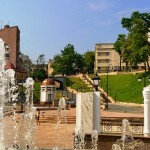
The traditional Turkish cities are usually located along historical trade routes, notably the silk and spice routes. Built on lands rendered unfavorable for cultivation, the cities display unique localized architectural styles reflecting regional conditions with an urbane and sophisticated building tradition.
Although each has a distinctive character of its own, all have a citade; one or more grand mosque complexes containing religious colleges and welfare establishments.
A traditional square corresponding to the western plaza; a number of old bath houses; traditional guild alleys jutting away from the bazaar area; and distinct neighborhoods where you are likely to find fine examples of traditional Turkish houses, often arranged around a courtyard.
Turks are wild about soccer. Budding future players will be kicking the ball around in the streets at all hours. In shades squares, the tables of coffee houses are occupied by townsmen, sipping coffee or tea, playing backgammon and discussing the issues of the day with their friends and neighbors. It is said that both coffee and the coffee house are among the many contributions made by Turks to the good life.
The sucks of coffee abandoned at the gates of Vienna by the retreating Ottoman army in the 16th century introduced the addictive brew to the West and made the cafes of Vienna world famous.
It is in these cities that both high style and localized culture evolved side by side, giving us the best examples of Turkish architecture as well as the best of folklore, traditional arts and crafts, customs and food.
The popular theater tradition, with its comedians, storytellers, and marionettes and shadow puppets evolved in the provincial cities. Performances were given in the public squares, for national and religious festivals, or at weddings and fairs, and at inns, coffee houses and private residences. All shows, including wrestling matches, were accompanied by music, with artists performing to the sound of the tambourine.
